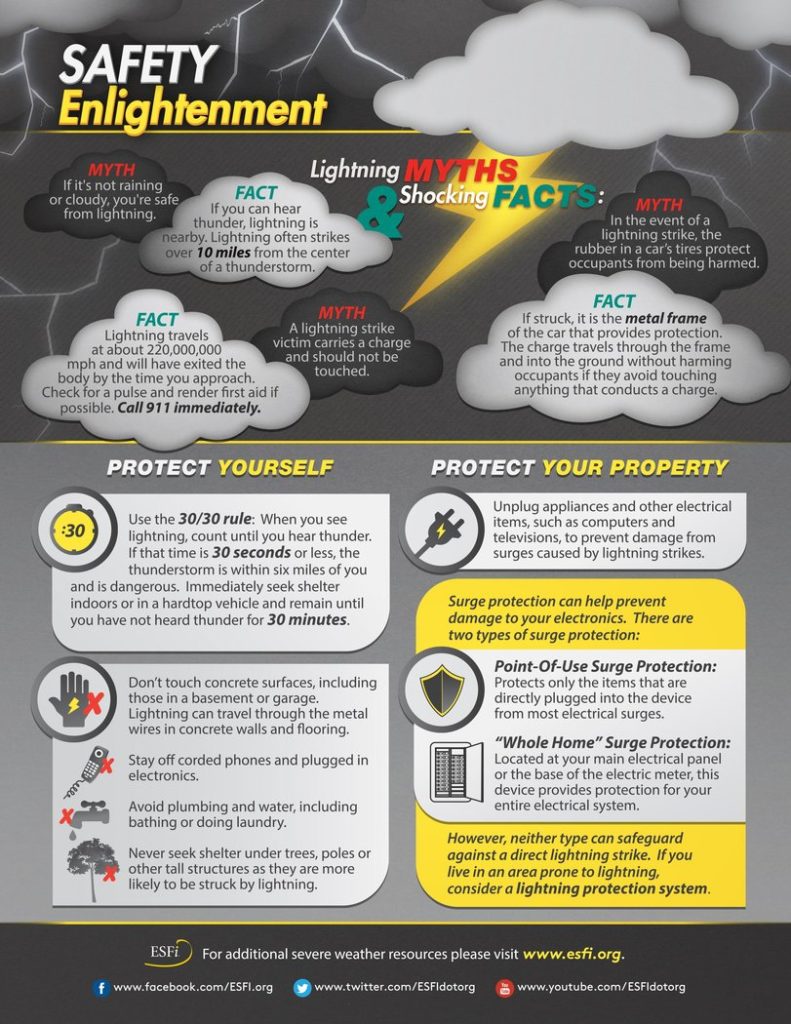
Lightning is Deadly
- An average of 22,600 fires were caused by lightning between 2007 and 2011
- According to Aon Benfield’s Impact Forecasting, insured losses from lightning strikes are at an all-time high.
- 30 people die a year from lightning strikes according to the National Weather Service
- According to the Lighting Protection Institute, the top 5 states most often struck by lighting are:
- Florida: 25.3 strikes per square mile
- Louisiana: 20.3 strikes per square mile
- Mississippi: 18.0 strikes per square mile
- Alabama 15.9 strikes per square mile
- South Carolina and Oklahoma (tied): 14.6 strikes per square mile
Lightning is Far Reaching
- 1/3 of all lightning related injuries occur indoors. Stay away from:
- Corded phones
- Electronics
- Plumbing
- Lightning can strike 10 miles from a thunderstorm
- Lightning can strike anywhere, not just the tallest objects
Lightning Protection
Power surges caused by lightning can damage the electronics in your home
- Lightning protection systems intercept lightning strikes and provide grounding path for dangerous electricity to discharge safely, leaving occupants and homes safe from harm
- Panel box surge protective devices (SPDs) serve as the first line of defence against harmful home electrical surges, limiting voltages by diverting currents at the electrical service entrance. Only qualified electricians should install SPDs
- Point of use surge protectors protect electronics plugged into the device from surges, must be replaced over time or after a major surge event
- Power strips do not provide surge protection
-
- Point-of-Use Surge Protection
Protects only the items that are directly plugged into the device from most electrical surges - “Whole Home” Surge Protection
Located at your main electrical panel or base of the electric meter, this device provides protection for your entire electrical systemNo surge device can handle a direct lightning strike. Unplug sensitive electronics well before a storm to prevent damageLighting Myths & Shocking Facts
- Myth: If it’s not raining or cloudy, you’re safe from lightning.
Fact: If you can hear thunder, lightning is nearby. Lightning often strikes over 10 miles from the center of a thunderstorm - Myth: A lightning strike victim carries a charge and should not be touched.
Fact: Lightning travels at about 220,000,000 miles per house and will have exited the body by the time you approach. Check for a pulse and render first aid if possible. Call 911 immediately. - Myth: In the event of a lightning strike, the rubber in a car’s tires protect occupants from being harmed.
Fact: If struck, it is the metal frame of the car that provides protection.
Protect Yourself
Use the 30/30 rule. When you see lightning, count until you hear thunder. If that time is 30 seconds or less, the thunderstorm is within 6 miles of you and is dangerous. Immediately seek shelter indoors or in a hardtop vehicle and remain until you have not heard thunder for 30 minutes.
Do not touch concrete surfaces, including those in a basement or garage. Lightning can travel through the metal wires in concrete walls and flooring.
Stay off corded phones and plugged in electronics
Avoid plumbing and water, including bathing or doing laundry
Never seek shelter under trees, poles, or other tall structures as they are more likely to be struck by lightning
Protect your Property
Unplug appliances and other electrical items, such as computers and televisions, to prevent damage from surges caused by lightning strikes
Surge Protection can help prevent damages to your electronics.
- Myth: If it’s not raining or cloudy, you’re safe from lightning.
- Point-of-Use Surge Protection